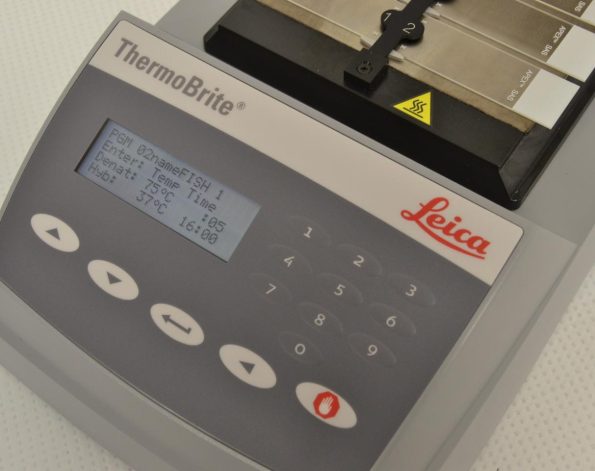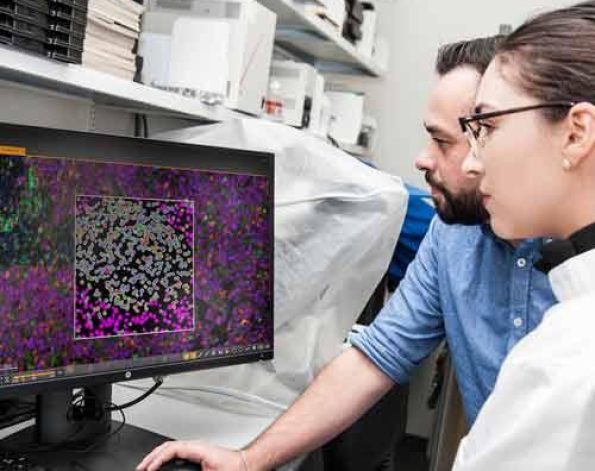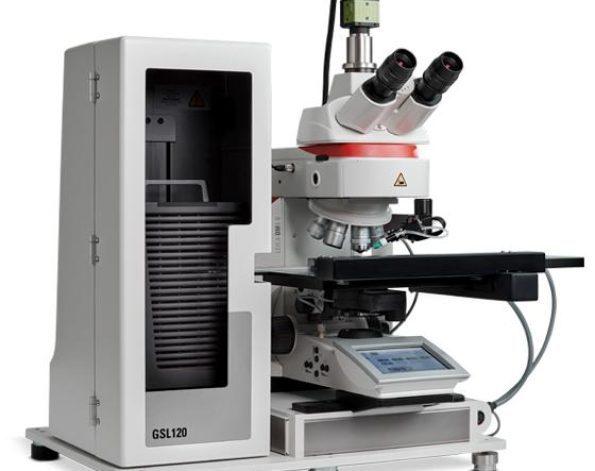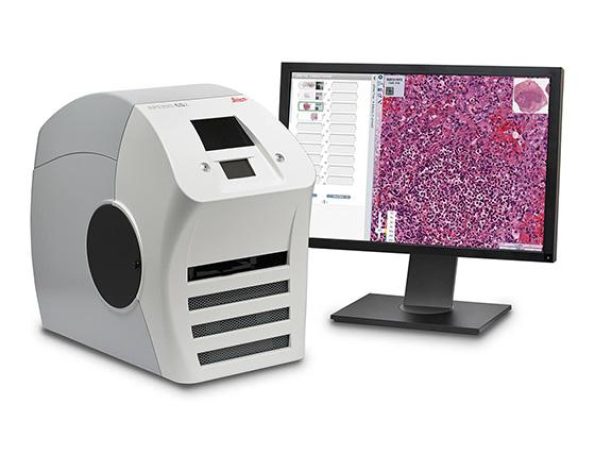เครื่องตัดระดับไมโครด้วยเลเซอร์ภายใต้กล้องจุลทรรศน์ ยี่ห้อ ไลก้า รุ่น LMD6 และ LMD 7
เราเคลื่อนย้ายเลเซอร์ ไม่ใช่ตัวอย่าง และเราใช้ระบบแรงโน้มถ่วงของโลกในการเก็บตัวอย่างที่สนใจ และนั่นคือเหตุผลที่ระบบ LMD ของเราให้การตัดที่สมบูรณ์แบบ ปราศจากการปนเปื้อน และพร้อมสำหรับนำไปวิเคราะห์
Laser Microdissection (LMD, หรืออีกชื่อหนึ่งคือ Laser Capture Microdissection หรือ LCM) ช่วยให้ผู้ใช้งานสามารถแยกเซลล์เดี่ยว หรือพื้นที่บางส่วนของเนื้อเยื่อออกมาจากตัวอย่างได้ ขับเคลื่อนด้วยการออกแบบเลเซอร์ที่เป็นเอกลักษณ์ พร้อมทั้งซอฟท์แวร์ที่มีประสิทธิภาพ Leica LMD จะช่วยให้ผู้ใช้งานสามารถแยกส่วนที่สนใจออกจากพื้นที่ทั้งหมดของเนื้อเยื่อให้กลายเป็นเซลล์เดียว หรือแม้แต่กลายเป็น subcellular structures เช่น โครโมโซมได้
Leica LMD ถูกใช้อย่างแพร่หลายในงานด้าน genomics (DNA), transcriptomics (mRNA, miRNA), proteomics, metabolomics, และ next generation sequencing (NGS). ซึ่งนักวิจัยทางด้านประสาทวิทยา, การวิจัยทางด้านมะเร็ง หรือนิติวิทยาศาสตร์ก็ได้มีการใช้วิธีนี้ ยิ่งไปกว่านั้น Leica LMD เป็นเครื่องมือที่สมบูรณ์แบบสำหรับการทำ live cell culture (LCC) เพื่อการโคลนนิ่ง และการทำ re-cultivation, manipulation หรือการทำ downstream analysis
Same Principle, Two Systems
LMD is typically used in genomics (DNA), transcriptomics (mRNA, miRNA), proteomics, metabolomics, and even next generation sequencing (NGS). Researchers in neurology, cancer research, plant analysis, forensics or climate research rely on this method. Furthermore, LMD is a perfect tool for live cell culture (LCC), for cloning and re-cultivation, manipulation or downstream analysis.
We move the laser, not the sample. And we use gravity for collection. That is why our LMD systems provide you with perfectly cut, contamination-free, analysis-ready dissectates.
Choose your system
The difference between the Leica LMD6 and Leica LMD7 is the laser. The LMD7 provides higher laser power and more laser controls than the LMD6. This makes the Leica LMD6 the tool for standard applications dissecting soft tissues such as brain, liver, or kidney. And it makes the Leica LMD7 ideally suited to dissect any kind of tissue independent of its size or shape.

We Move the Laser, not the Sample
Try writing your name on a piece of paper by moving the paper instead of the pen. Hard to do? That’s why we move the laser, not the sample for laser microdissection.
Only Leica Microsystems uses high-precision optics to steer the laser beam along the desired cut line on the tissue with prisms. That means that the Leica LMD cuts perpendicularly to the tissue and leaves clean cuts of contamination-free isolates.
Precision. Always.
- Cut with highest possible precision and speed
- Cut directly, real-time with “Move and Cut”

Laser Adjustment for your Sample
The LMD7’s power, aperture, speed, head current, and pulse frequency settings are tunable to the needs of your sample. For example, thick plant sections require high power, while cutting around fragile neurons will require less power. Thin sections can typically use faster cuts than thick sections.
Advanced cutting modes add enhanced precision to how you will dissect your sample. For example you can draw first and cut afterwards (Draw + Cut), or cut in real-time by mouse click or with a PEN screen (Move + Cut). The Draw + Scan mode is made for ablation from glass, whereas the Laser Screw cuts thick specimen in consecutive rounds. The Final Pulse mode enables you to kick demanding dissectates into the collection vessel.

Gravity for Cleanliness
Your downstream analysis relies on contaminate-free isolates. This is why Leica LMD systems collect dissectates via gravity. Their unique laser-guidance based dissection method preserves the integrity of your isolates – contact-free and contamination-free.
1, 2, 3 – contamination-free sample!
- You choose the area of interest
- You move the laser along the area to be cut out
- The dissectate drops into the Petri dish and is ready for further analysis
The real asset: Gravity always works.
Leica Laser Microdissection Software
The Leica LMD software is an intutive application software designed to streamline the process of selecting settings so that you can focus on obtaining high-quality regions of your sample. Select, dissect, and visualize with ease!
- Control laser and microscope
- Guide the laser beam by mouse or pen screen
- Create a Specimen Overview for better orientation
- Detect and cut your samples automatically
The Leica LMD Software connectivity:
- Use your self-made pattern recognition software
- Import your ROIs from other devices e.g. slide scanners

Automation Options
The ADM (Auto Detection Mode) is a software module which helps collect large amounts of similar dissectates. You just have to encircle a region you are interested in and the software will use this as a template for other regions. For example, Proteomics analysis requires a large amount of sample to be captured, and ADM has provided a great benefit to labs working with 100’s-1000’s of dissectates.
Autofocus can be used before each dissection process to keep the focus of hundreds of ROIs distributed over the slide. Moreover, you can automatically inspect and document all collection devices which were used.
The systematic approach: A raster tool separates your Field of View into a given number of regions. With this function, you can systematically dissect your specimen and collect your dissectate into a variety of collection devices such as 96-Well plates.
 Before auto-detectionAfter auto-detection
Before auto-detectionAfter auto-detection
Interface for Artificial Intelligence
Aivia is our AI-based, image visualization, analysis and interpretation platform. With the help of AI-enhanced tools such as the Pixel Classifier, Aivia can be used to automatically define Regions of interest (ROI) which are destined for Laser Microdissection (LMD). ROIs can be detected by Aivia and imported directly into the LMD software for Microdissection.
Besides Aivia other external software can be used for automatic ROI detection. The LMD software simply needs an XML file containing the ROI information.
- Mund et al., Nature Biotechnology, 2022 https://doi.org/10.1038/s41587-022-01302-5
- Mitchell et al., JoVE, 2022 https://doi.org/10.3791/64171

High-Throughput Capability
Need more throughput? The LMD systems can be configured with different kinds of stages. The LMT350 ultra scanning stage provides the fastest, most silent and most precise navigation among them.
The LMT350 is capable of holding collector vessels starting from 0.2 ml tube caps, through 8 and 12 cap-strips up to standard 96-well and 386-well plates*. This enables you to do high-throughput experiments.
Because you don’t need any special material but use regular microtiter plates, these plates can be loaded directly into standard PCR machines.
*max.352 wells addressable
Consumables
A) Specimen
Leica Microsystems offers different slide options for laser microdissection.
- Use any kind of membrane slides for genomics and transcriptomics
- Use PET slides for certain applications in proteomics and metabolomics because PET is almost free of softeners.
- Choose DIRECTOR slides to work completely membrane free
Read how to choose the adequate consumable for Laser Microdissection.
B) Collection
Since the Leica LMD systems collect dissectates simply by gravity, you can use standard devices for their collection. Just use common molecular biology reaction devices such as 0.2 or 0.5 ml tube caps – which you already have in your lab. Collection devices can be dry or filled with reaction buffer or culture media for the LMD application.

Success is Objective
LMD objectives are designed for the task of enabling flexible laser settings for unique applications. Leica’s development and manufacturing of optics has been among of our core competencies from the start in the 19th century, so you can rely on the performance of our dedicated LMD objectives.
- Choose from a range of dry objectives – from 2.5x to 150x
- Use the 150x SmartCut objective to go into detail with high magnification when required
- Get a large field of view to cut large parts of samples in one piece with low-magnification objectives
- Benefit from objectives with the highest possible transmission of laser light at 350 nm to cut tissue, bones, teeth, brain, plants, chromosomes and living cells – try them for your application!
The outstanding imaging performance our objectives provide goes without saying.

LCC – Live Cell Cutting
If you work with live cells, you are used to working with inverted microscopes. Live cell cutting works with our LMD systems, even though the Leica LMD systems are based on an upright microscope.
- You can dissect living cells in culture in order to re-cultivate, clone, or analyze single cells, colonies, or cell clusters
- You can attach a climate chamber to the LMD system
- You can grow cells on petri dishes with PEN membrane or multi-well ibidi slides
- You can collect the dissectate of living cell cultures into Petri dishes with or without PEN membrane, ibidi slides, or 8-stripe tubes for re-cultivation, or into collection devices such as PCR tube caps for analysis
Read more about live cell cutting in our Science Lab article on consumables.

Combination System: LMD System with THUNDER Imaging
The LMD6 and LMD7 systems can be combined with THUNDER. The base stand of the THUNDER Imager 3D Tissue and LMD systems are the same, thus such a combination offers:
- Lab space savings with one system for different tasks
- Laser Microdissection with the LMD without limitation
- Brilliant THUNDER fluorescence imaging using LAS X, even in multi-color and 3D (z-stacks) and visualization in the 3D viewer.
Dedicated Laser Microdissection Objectives
Leica Microsystems offers a portfolio of dry objectives dedicated for Leica LMD systems. These special LMD objectives feature the highest possible UV-transmission and outstanding imaging performance – the Leica SmartCut series (5x–150x).
| Objective | Mag. | NA | WD (mm) | BF, POL | FL | DIC, PH | LMD | CI | SOV |
| HCX PL FLUOTAR** | 1.25x | 0.04 | 3.7 | + | + | – | – | – | +++ |
| PLAN** | 4x | 0.1 | 26.2 | + | + | – | + | ++ | ++ |
| UVI | 5x | 0.12 | 11.7 | + | + | – | +++ | ++ | ++ |
| HI PLAN | 6.3x | 0.13 | 12.8 | + | + | – | +++ | ++ | ++ |
| HCX PL FLUOTAR | 10x | 0.3 | 11.0 | + | + | + | +++ | + | + |
| UVI | 10x | 0.25 | 2.9 | + | + | + | +++ | – | + |
| HCX PL FLUOTAR | 20x | 0.4 | 6.9 | + | + | + | +++ | + | + |
| HCX PL FLUOTAR | 40x | 0.6 | 3.3–1.9 | + | + | + | +++ | – | – |
| HCX PL FLUOTAR | 63x | 0.7 | 2.6–1.8 | + | + | + | +++ | – | – |
| HCX PL FLUOTAR | 150x | 0.9 | 0.25 | + | + | + | +++ | – | – |
Mag. – magnification; NA – numerical aperture; WD – working distance; BF – brightfield; POL – polarized light; FL – fluorescence; DIC – differential interference contrast; PH – phase contrast; LMD – laser microdissection; CI – cap inspection; SOV – specimen overview; + = suitable; – = not suitable; ++ = dedicated for; +++ = most suitable
** Additionally recommended objectives
Technical Specifications
| Dissection | Dissection and Collection Unit Based on Scanning Stage | Dissection and Collection Unit Based on Motorized Stage | Dissection and Collection Unit Based on Scanning Stage LMT350 |
| Specimen Collection | Contact- and contamination-free | ||
| Dissection modes | Draw & Cut Move & Cut (direct online cutting) PtoP (point-to-point) Draw & Scan (dot dissection scan) LMD screw (cut subsequently in Z-direction) Shadow Cuts (parallel draw and dissection) | ||
| Serial section cutting | Yes | No | Yes |
| AVC+ basic AVC+ professional | Yes Yes | Yes Not recommended | Yes |
| Universal holder | Yes | No | No |
| Stage repeatability | +/- 1 µm | +/- 10 µm | <=+/- 0.5 µm |
| Stage max. travel speed | 20 mm/s | 200 mm/s | |
| Stage drive | Ball bearing screw | Rack/ pinion | Linear motor drives |
| Holders | 3x standard slides (25 mm x 76 mm) Optional: 1x big slide (50 mm x 76 mm) or 2x standard slides (25 mm x 76 mm) Petri dish (50 mm) 18-well slide (stack) | 1x standard slide (25 mm x 76 mm) Optional: 1x big slide (50 mm x 76 mm) or 2x standard slides (25 mm x 76 mm) Petri dish (50 mm) | 4x standard slides (25 mm x 76 mm) Optional (combinations possible): 1x big slide (50 mm x 76 mm) 2x Petri dishes (50 mm) 2x 18-well Ibidi slide stacks |
| Collectors | 4x 0.2 ml standard PCR tubes 4x 0.5 ml standard PCR tubes Petri dish (50 mm) Optional: 2x 8-well strips building up a 96-well plate Height adjustable universal collector (for multi-well slides, 8-strips, 8-strip tube caps, …) 48-well collector (6×8-strip tube caps) (2x for a full 96-well plate) | 4x 0.2 ml standard PCR tubes 4x 0.5 ml standard PCR tubes Optional: 1x 8-well strips building up a 96-well plate | 4x 0.2 ml standard PCR tubes 4x 0.5 ml standard PCR tubes 2x Petri dishes (50 mm) Optional: 96-PCR-well plate (non-skirted or semi-skirted) 96-LCC-well plate 2x 18-well Ibidi slides 1 x 8-strip, 1 x 12-strip 1.5 ml tube (with or without filling) |
| Power supply | CTR6/CTR6 LED | Dual SP box | |
| Laser | Leica LMD7 | Leica LMD6 | |||
| Type | Diode pumped, solid state | Diode pumped, solid state | |||
| Wavelength | 349 nm | 355 nm | |||
| Average pulse energy | 120 µJ | 70 µJ | |||
| Repetition rate | 10 – 5000 Hz (free adjustable) | 80 Hz (fix) | |||
| Laser aperture control | Yes, continuously adjustable | ||||
| Free intensity control | 1-100% | ||||
| UV offset freely adjustable and saved for each objective | Yes | ||||
| Laser beam movement | Via optics | ||||
| Microscope stand (fully automated DM6 B) | |||||
| Transmitted light (TL) axis | Contrast methods | BF, optional PH, DF, POL, DIC (fully automated) | |||
| Illumination | LED (PMax = 15 W ) Lamphousing | ||||
| Automation | Automated illumination manager Automated contrast manager Constant color intensity control (CCIC) for Halogen TL | ||||
| Condenser | Condenser head S28, 0.55 NA Motorized 7x condenser disk Motorized polarizer | ||||
| Fluorescence axis | Filter cube turret | Motorized 5x or 8x | |||
| Automation | Fluorescence intensity manager (FIM) for brightness adjustment Circular and rectangular field diaphragms for eyepiece or camera viewing Internal filter wheel and motorized Excitation Manager | ||||
| Illumination | Leica EL6000 (120 W metal halide) or 100 W HBO | ||||
| Cubes (individual filters available upon request) | Special cubes (size k) for simultaneous fluorescence and laser application | ||||
| LMD-BGR LMD-GFP band pass LMD-GFP long pass LMD-Cy3 LMD-DAPI | LMD-Alexa594 LMD-CFP LMD-GFP/Cy3 LMD-YFP LMD-Cy5 | ||||
| Operation | Focus | Motorized: – 5 electronic ratios – Includes parfocal function Memory function for two z-positions | |||
| Objective turret | Motorized 7x M25 thread including dry and immersion modes | ||||
| Controls | 6 programmable function buttons | ||||
| Leica SmartMove Controls for z (focus) movement and x, y (stage) movement 4 programmable function buttons | |||||
| Optional Leica STP8000 Controls for z (coarse and fine focus) and x, y (stage) movement 11 programmable function buttons Touchscreen with information and control panels | |||||
| Stand | Display | With integrated touchscreen Leica SmartTouch | |||
| Interfaces | 2 x USB 2.0, 2 x I2C | ||||
| Dimensions | With scanning stage: 649.6 mm height, 512.0 mm width, 596.5 mm depth | ||||
| System software (Operating System Microsoft® Windows® 7) | |||||
| Package includes (selected features) | Dissection | Automated collection devices and positioning of PCR tubes Fully automated inspection mode Multi-cutting over entire slide Save and load drawn shapes | |||
| User guidance | Workflow based graphical user interface Free scaling of drawn shapes Save user profiles Overview images in BF and Fluorescence | ||||
| Control | Full laser control Control software of microscope stand Laser and illumination settings are linked to objectives | ||||
| Interfaces | Export shape list data for Microsoft Excel or OpenOffice | ||||
| Optional software packages | Automated vision control (AVC+ basic) for automated cell recognition within field of view only Automated vision control (AVC+ professional) for fully or semi automated cell recognition over freely defined area Integrated database to transfer relevant data (laser, microscope and camera; database as optional) | ||||




